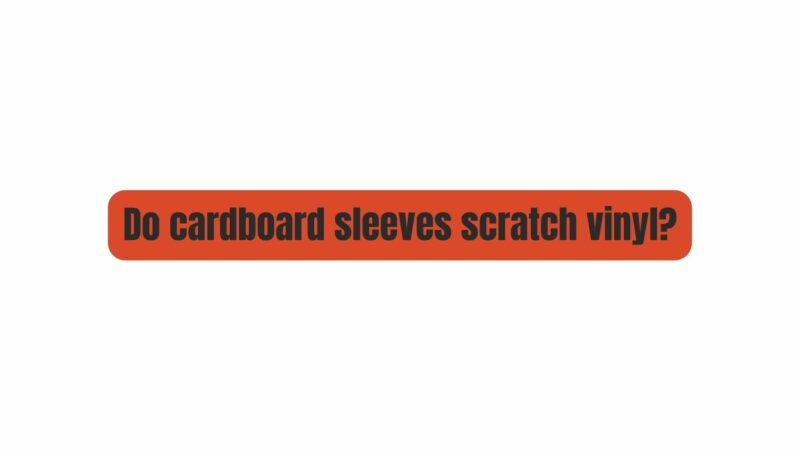The resurgence of vinyl records in recent years has brought with it a renewed interest in the various aspects of vinyl care and maintenance. Among the many debates within the vinyl community, one question that often arises is whether cardboard sleeves, commonly used as inner sleeves for vinyl records, pose a risk of scratching these cherished analog treasures. In this article, we will delve into the world of cardboard sleeves to determine whether they can potentially harm vinyl records, examining the advantages and disadvantages of their use in preserving these fragile musical gems.
Understanding the Role of Cardboard Sleeves
Before delving into the potential for cardboard sleeves to scratch vinyl records, it is crucial to comprehend their role in the vinyl ecosystem. Cardboard sleeves, also known as inner sleeves, inner covers, or dust sleeves, serve a vital purpose in protecting vinyl records. These sleeves typically consist of thin cardboard material and are designed to slide inside the record jacket, enveloping the vinyl record and guarding it against dust, debris, and potential surface damage.
Advantages of Cardboard Sleeves
- Dust and Debris Protection: One of the primary functions of cardboard sleeves is to create a protective barrier that shields vinyl records from dust, dirt, and other particulate matter. Dust particles can infiltrate the grooves of a record, leading to unwanted pops and crackles during playback. Cardboard sleeves serve as a safeguard, helping to prevent such contamination.
- Minimizing Static: Cardboard sleeves can aid in minimizing static build-up on the vinyl surface. Static electricity can attract dust and negatively impact sound quality, so the anti-static properties of cardboard sleeves can help maintain better audio fidelity.
- Label Visibility: Cardboard sleeves often have a cutout or a transparent window that allows the record label to remain visible. This feature is advantageous for quickly identifying the contents of a record, especially in larger collections.
- Cost-Effective: Cardboard sleeves are generally more cost-effective than some alternative materials like polyethylene or polypropylene, making them a popular choice for vinyl enthusiasts, particularly those with extensive collections.
Disadvantages of Cardboard Sleeves
- Abrasive Potential: Cardboard sleeves, particularly if made from lower-quality materials or poorly manufactured, can contain rough edges or burrs. These irregularities have the potential to scratch the vinyl surface when inserting or removing the record from the sleeve.
- Moisture Absorption: Cardboard is susceptible to moisture absorption. In high humidity environments, cardboard sleeves can become damp, potentially causing damage to the record labels or the vinyl itself.
- Fraying and Wear: Over time and with frequent use, cardboard sleeves can experience wear and tear. The edges may fray, and the cardboard may weaken, potentially posing a higher risk of scratches to the vinyl.
- Not Ideal for Valuable Records: Collectors with rare or valuable vinyl records may opt for alternative sleeves, such as polyethylene or polypropylene, which offer superior protection against potential damage.
Exploring Alternative Sleeve Options
- Polyethylene Sleeves: Polyethylene sleeves are a popular alternative to cardboard sleeves. They are clear, provide excellent protection against dust, static, and moisture, and are generally smoother and less abrasive. However, they tend to be more expensive.
- Polypropylene Sleeves: Similar to polyethylene, polypropylene sleeves are clear, durable, and provide superior protection. They are slightly more rigid than polyethylene, which can make inserting and removing records easier.
- Rice Paper Sleeves: Rice paper sleeves are a compromise between cardboard and polyethylene. They offer the gentleness of cardboard sleeves while being less prone to moisture absorption.
- Cork and Felt Sleeves: Cork and felt sleeves are designed to protect records during storage and playback. They are particularly useful for preventing static and reducing vibrations but may not be as effective at dust protection.
Conclusion
In the ongoing discussion surrounding whether cardboard sleeves can scratch vinyl records, the answer is not a straightforward “yes” or “no.” Cardboard sleeves offer advantages such as dust protection, anti-static properties, and affordability, but they also have disadvantages like the potential for abrasive edges and moisture absorption.
Ultimately, the choice of sleeve material depends on your specific needs and preferences. For collectors with extensive collections and budget constraints, cardboard sleeves may be a reasonable choice, provided they are of good quality and handled with care. However, for those with rare or valuable vinyl records or a willingness to invest in superior protection, alternatives like polyethylene or polypropylene sleeves may be a better option.
Regardless of the type of sleeve chosen, the key to preserving your vinyl records lies in proper storage and handling. Store records vertically in a cool, dry environment, and handle them with the utmost care to ensure they continue to provide the warm, rich sound that vinyl enthusiasts hold dear.


